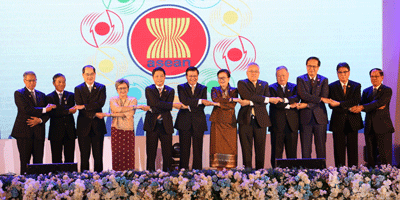Prime Minister Thongloun Sisoulith has raised a seven-point agenda calling for ASEAN economic ministers to place discussion focus on pursuing the 2025 ASEAN economic goals.
The PM proposed the agenda while he was delivering his opening remarks at the 48th ASEAN Economic Ministers’ Meeting that took place yesterday at Don Chan Palace Hotel in Vientiane.
To pursue the ASEAN Economic Community (AEC) Blueprint 2025, which was adopted by Asean leaders at the 27th ASEAN Summit held in November last year in Kuala Lumpur, Malaysia, the Lao Prime Minister raised the seven-point agenda as follows:
1.To ensure the effective implementation of the ACE Blueprint 2025 by putting in place the appropriate mechanisms including the sectoral work plans, coordination mechanisms as well as a systematic monitoring and evaluation framework.
2. To continue to enhance the business environment through the reduction of business costs and improved trade facilitation, especially by reducing and eventually eliminating non-tariff barriers.
3. To reaffirm the principle of ASEAN consensus and ASEAN centrality in negotiation and engagement with dialogue partners.
4. To ensure the realisation of the theme “Turning Vision into Reality for a Dynamic ASEAN Community,” especially by effective delivery of the eight priorities of ASEAN Economic Pillar under the Lao PDR’s Chairmanship 2016.
5. To continue narrowing the development gap among and within ASEAN member states to achieve equitable economic development in the region.
6. To ensure realisation of benefits for ASEAN businesses from the trade agreements between ASEAN and its dialogue partners by taking into consideration the interest and capacity of businesses.
7. To ensure the active engagement of businesses in the implementation of the AEC Blueprint 2025.
The Prime Minister noted that since its establishment, ASEAN- the regional 10-member bloc has made great achievements across many areas, notably in maintaining macro-economic stability and strengthening economic resilience, resulting in sustainable economic growth.
He added that the establishment of the AEC by the end of last year is a critical and historical milestone in the ASEAN economic integration journey as the region with more than 600 million consumers transforms into a single market and production base with free flow of goods, services and investment, skilled labour and freer flow of capital.
“This has turned ASEAN into a competitive region that is integrated globally and a rule-based region with more harmonised regulatory frameworks,” he told the opening ceremony.
ASEAn economic ministers, ASEAN Secretary General Le Luong Minh and other participants attended the event.
PM Thongloun stated that ASEAN still has to complete its unfinished agenda under the AEC Blueprint 2015, especially services liberalisation.
In terms of trade in goods, ASEAN should focus more on trade facilitation issues, especially to address non-tariff barriers as well as simplify customs procedures.
“Asean should also continue improving its regulatory frameworks, mechanisms and procedures in order to enhance the business environment and turn ASEAN into a preferred global investment destination,” he said. In her welcoming address, Lao Minister of Industry and Commerce Khemmani Pholsena said ASEAN endorsed the eight priority deliverables for Laos’ ASEAN Chairmanship under the economic pillar and tasked their officials with ensuring their timely delivery.
These eight priorities cover critical areas of trade facilitation, food safety, access to finance for micro, small and medium enterprises (MSMEs), enabling environment for MSMEs, tourism, special economic zone development and collaboration, and narrowing the development gap among ASEAN member states. The establishment of the AEC in 2015 was a major milestone in the regional economic integration agenda in ASEAN, offering opportunities in the form of a huge market of US$2.6 trillion. In 2014, the AEC was collectively the third largest economy in Asia and the seventh largest in the world.
Source: Vientiane Times



